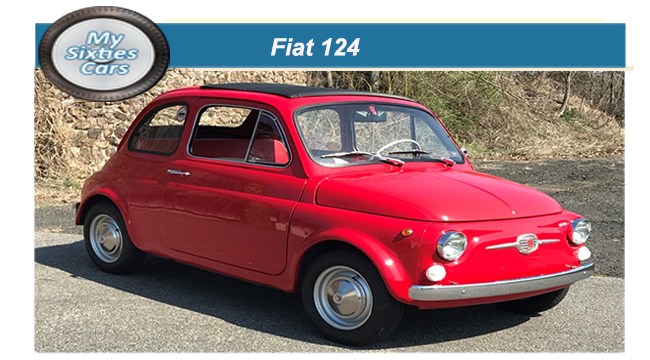 The successor to the legendary 'Topolino,' the 500 s was Fiat's most famous baby people's car.
The successor to the legendary 'Topolino,' the 500 s was Fiat's most famous baby people's car.
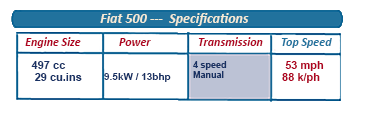 The 500’s handling was first class, with wonderfully direct steering.
Fiat launched the model as the `Nuova 500' on a very a similar layout to the 600. A rear-mounted engine drove the rear wheels, and the car featured all-round independent suspension and rear-hinged 'suicide' doors.
A first for Fiat was the 500's air-cooled engine, a two-cylinder 479cc (29 cu in) unit producing 10kW (13bhp) attached to a four-speed manual gearbox with a floor-mounted gear lever.
The 500’s handling was first class, with wonderfully direct steering.
Fiat launched the model as the `Nuova 500' on a very a similar layout to the 600. A rear-mounted engine drove the rear wheels, and the car featured all-round independent suspension and rear-hinged 'suicide' doors.
A first for Fiat was the 500's air-cooled engine, a two-cylinder 479cc (29 cu in) unit producing 10kW (13bhp) attached to a four-speed manual gearbox with a floor-mounted gear lever.
 For a year or more after it’s launch Fiat were not impressed by sales for the 500, and it was only after the company decided to launch two distinctive versions: the 11kW (15bhp) `Economica' and the 'Normale' that sales began to take off.
The `Nuova 500', designed by Dante Giacosa, instantly became the definitive "Cinquecento" ( City Car) Small, inexpensive and reliable, the Fiat 500 rapidly replaced the hundreds of motor scooters that crowded the streets of Italy's cities and towns, taking the decibel levels down several notches in the process.
The people of Milan, later all of Italy and then Western Europe fell in love with the Fiat 500 becasue not only was it extremely econcomical it was insanely cute.
For a year or more after it’s launch Fiat were not impressed by sales for the 500, and it was only after the company decided to launch two distinctive versions: the 11kW (15bhp) `Economica' and the 'Normale' that sales began to take off.
The `Nuova 500', designed by Dante Giacosa, instantly became the definitive "Cinquecento" ( City Car) Small, inexpensive and reliable, the Fiat 500 rapidly replaced the hundreds of motor scooters that crowded the streets of Italy's cities and towns, taking the decibel levels down several notches in the process.
The people of Milan, later all of Italy and then Western Europe fell in love with the Fiat 500 becasue not only was it extremely econcomical it was insanely cute.
![]()
Essentially, the Economica was the original `Nuova 500', but with a more powerful engine and lower price tag.
The Normale also had the uprated engine, plus various other upgrades.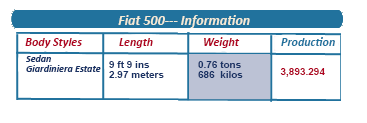 These improvements included opening door windows and a more usable rear seat.
These improvements included opening door windows and a more usable rear seat.
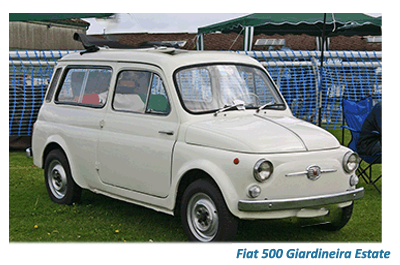 By the late Fifties, Fiat had introduced a 'Sport' model, inspired by some epic performances by the 500 on the track, notably a first, second, third and fourth in class at the Hockenheim 12-hour race.
By the late Fifties, Fiat had introduced a 'Sport' model, inspired by some epic performances by the 500 on the track, notably a first, second, third and fourth in class at the Hockenheim 12-hour race.
 The Fiat 500 Sport was next to arrive, this time fitted with an updated version of the standard engine, enlarged to 499cc (30 cu in), with a revised camshaft, valves, cylinder head and fueling.
As a result, the Sport version now produced a very respectable 16kW (21.5bhp).
With a distinctive red stripe down each side, the Sport was difficult to miss. Another feature was its solid roof, in contrast to the canvas roll-back roof found on standard production cars. The Sport was offered with an open-air option from 1959.
The Fiat 500 Sport was next to arrive, this time fitted with an updated version of the standard engine, enlarged to 499cc (30 cu in), with a revised camshaft, valves, cylinder head and fueling.
As a result, the Sport version now produced a very respectable 16kW (21.5bhp).
With a distinctive red stripe down each side, the Sport was difficult to miss. Another feature was its solid roof, in contrast to the canvas roll-back roof found on standard production cars. The Sport was offered with an open-air option from 1959.
A `Giardiniera' estate version was introduced for 1960, which rode on a stretched wheelbase and differed from the saloon by having a horizontally mounted engine.
![]()
Later that same year, the 500D was released, fitted with a 499cc (30 cu in) engine from the discontinued Sport, but with reduced power output of 13kW (18bhp).
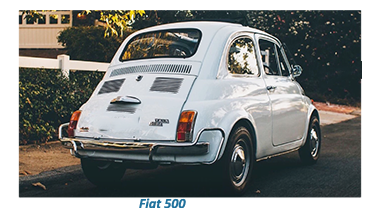
As well as the upgraded interior trim, there were external differences also, most notably the thin, miniature bull-bars adorning the front and rear bumpers.
Inevitably, demand for the 500 started to fall, and the arrival of the bland Fiat Panda in 1980 finally heralded the end of the 500.



